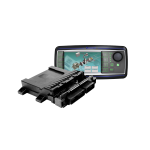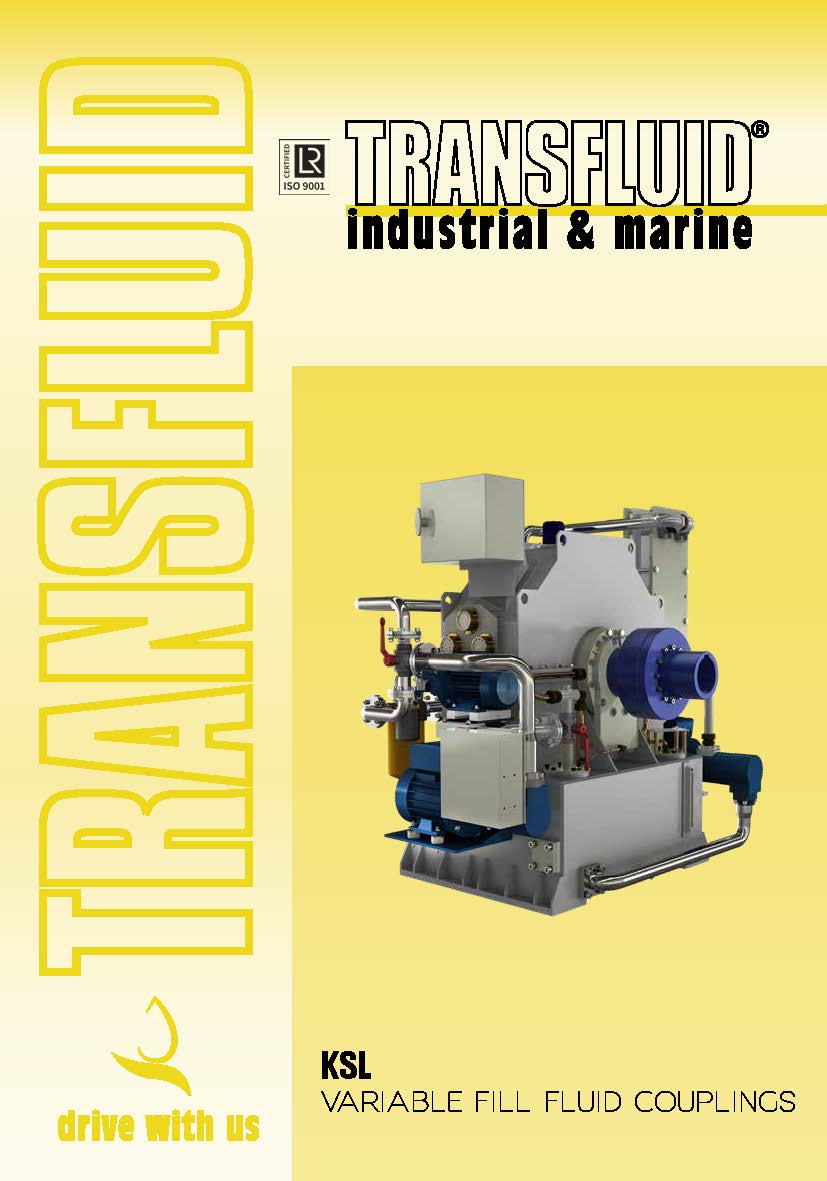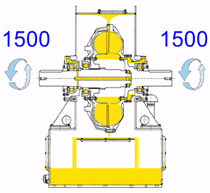TURBO COUPLING – HYDRAULIC COUPLING
Transfluid has designed their KSL series variable fill fluid coupling to overcome problems experienced at “start-up” and “speed variation” operation for medium and high power machines driven by electric motors and internal combustion engines.
HYDRAULIC COUPLING: WORKING OPERATION
Extremely efficient performance is achieved operating the fluid coupling KSL’s very simple and effective principle. Oil, which is the power medium, is pumped from a sump to the hydrodynamic coupling circuit, where it is finally “drained off” through a series of orifice plugs, back into the sump.
The “START-UP” principle:
By controlling the coupling’s feed pump oil flow to the working circuit by a small A.C. frequency converter, fill variation in the couplings interior working circuit alter the coupling slip characteristics, which softens the “start-up” dramatically.
The “VARIABLE SPEED” principle:
The same principle used to control the start-up permits the KSL to operate as a variable speed drive, varying the speed between input and output.
Its “TORQUE LIMITING” function:
Another KSL feature is its ability to limit the torque transmitted, slipping for a time and then dumping its circuit oil, disconnecting the driven machinery. The quick disconnection is possible by the installation of a quick release valve.
The key “KSL” features are:
- soft start
- variable speed
- torque limiting
HYDRAULIC COUPLING: FEATURES
Soft starter
The KSL’s fluid coupling working circuit is gradually filled with oil from an empty condition to a filled state. Such behavior enhances an extremely soft controlled start-up, especially with high inertia machinery. The KSL’s variable oil feed system is controlled by a frequency converter during the ramp-up, producing the ideal soft starter.
Accurate speed variation
By operating either manually or by the frequency converter controller, the KSL always guarantees output speed accuracy, as required by the operator or control system.
Vibration Dampening
One of the most important characteristics of KSL fluid coupling is its torsional vibration dampening effect, protecting both the driven machine and the motor or engine.
Overload Protection
This is a fluid coupling peculiarity and a big benefit to users. Even more protection can be achieved by installing “quick release drainable valves” which discharge oil from the working circuit in a few seconds, limiting any prolonged overload period completely.
High Efficiency
The KSL is an extremely efficient device compared to the constant filled type fluid coupling, as its volume of working circuit is controlled at the fullest possible volume to maintain a minimal slip rate.
Shaft Labyrinth Sealing
This makes the KSL variable fill fluid coupling series a low-maintenance piece of equipment.
Ease of Maintenance
Thanks to its split casing design, it’s possible to remove the complete fluid coupling impeller assembly without having to move either the motor/engine or driven machinery, saving the need for realignment and costly downtime. In addition all the accessories are externally mounted allowing an easy and fast replacement in case of need.
SELECTION OF THE RIGHT COUPLING
To correctly select the right variable fill fluid coupling, Transfluid needs to know the following:
- Motor/Engine type, power and speed
- Driven machinery type, power and speed
- Output speed range
- Environmental conditions
- Cooling water characteristics
- Assembly configuration
- Drive and driven shaft dimensions and tolerances.
HYDRAULIC COUPLING: ACCESSORIES
 MPCB
MPCB
The MPCB for KPTB and KSL, is an electronic device, designed and manufactured by Transfluid, with Transfluid’s proprietary software, capable of performing the following functions:
- Monitoring of input and output fluid coupling speed
- Monitoring of all fluid coupling parameters
- Sending fc status and alarm signals to the main control room
- Implementation of interlock logics
- Local or remote output speed control






 TRANSFLUID S.p.A. – Cap. Soc. EUR 520'000 – C.F./P.IVA 00790770150 – R.E.A. VA 0310612 – N. Mecc. VA 059280 – VAT NUMBER IT 00790770150
TRANSFLUID S.p.A. – Cap. Soc. EUR 520'000 – C.F./P.IVA 00790770150 – R.E.A. VA 0310612 – N. Mecc. VA 059280 – VAT NUMBER IT 00790770150